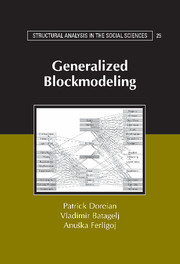Book contents
- Frontmatter
- Contents
- Preface
- 1 Social Networks and Blockmodels
- 2 Network Data Sets
- 3 Mathematical Prelude
- 4 Relations and Graphs for Network Analysis
- 5 Clustering Approaches
- 6 Optimizational Approach to Conventional Blockmodeling
- 7 Foundations for Generalized Blockmodeling
- 8 Blockmodeling Two-Mode Network Data
- 9 Semirings and Lattices
- 10 Balance Theory and Blockmodeling Signed Networks
- 11 Symmetric–Acyclic Blockmodels
- 12 Extending Generalized Blockmodeling
- Bibliography
- Author Index
- Subject Index
- Titles in the series
8 - Blockmodeling Two-Mode Network Data
Published online by Cambridge University Press: 13 January 2010
- Frontmatter
- Contents
- Preface
- 1 Social Networks and Blockmodels
- 2 Network Data Sets
- 3 Mathematical Prelude
- 4 Relations and Graphs for Network Analysis
- 5 Clustering Approaches
- 6 Optimizational Approach to Conventional Blockmodeling
- 7 Foundations for Generalized Blockmodeling
- 8 Blockmodeling Two-Mode Network Data
- 9 Semirings and Lattices
- 10 Balance Theory and Blockmodeling Signed Networks
- 11 Symmetric–Acyclic Blockmodels
- 12 Extending Generalized Blockmodeling
- Bibliography
- Author Index
- Subject Index
- Titles in the series
Summary
In developing a more general approach to blockmodeling, we have emphasized the use of direct methods in an optimizational approach (Chapter 6) and the creation of an (indefinitely) expanding set of block types and the formulation of new types of blockmodels (Chapter 7). We have confined our attention to one-mode social network data in which a social relation(s) is defined over one set of social actors. We have also stressed the generality of our methods and have suggested that generalized blockmodeling could be applied to other data structures. In this chapter we return to this idea and focus our attention on two-mode data. In Section 8.1 we define two-mode data and, in Section 8.2, we sketch some (but not all) approaches that have been taken with data of this form. Section 8.3 contains a brief proposal for extending generalized blockmodeling to two-mode data, and Section 8.4 presents our formalization of blockmodeling for such data. Section 8.5 describes some applications of these new tools in different substantive contexts.
TWO-MODE NETWORK DATA
Two-mode data can be defined in terms of two sets of social network actors. As Wasserman and Faust (1994:29–30) put it, “a two-mode network data set contains measurements on which actors from one of the sets have ties to actors in the other set.” Pairs of network actor types and relations include the following: organizations employing people and organizations of one type, such as corporations, sending resources, such as money, to organizations of a different type such as nonprofit social service agencies (see Galaskiewicz 1985). For these examples, the formulation in terms of two sets of so-called actors works.
Information
- Type
- Chapter
- Information
- Generalized Blockmodeling , pp. 247 - 270Publisher: Cambridge University PressPrint publication year: 2004
